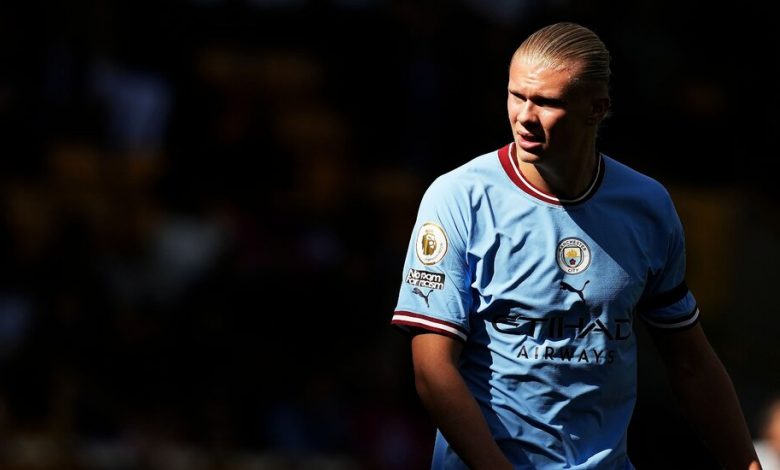How Do You Stop Erling Haaland? You Don’t.

MANCHESTER, England — Pellegrino Matarazzo starts with the bad news. In theory, he should be in possession of what may be the most valuable single piece of knowledge in world soccer. Twice in his time as the coach of VfB Stuttgart, Matarazzo has faced a team that featured Erling Haaland. And twice, he has managed to shut him down.
Haaland was part of the Borussia Dortmund team that visited Stuttgart in April 2021. He was on a hot streak then, in the middle of a run that would see him score 20 goals in his final 19 games of the season. He did not, though, score against Matarazzo’s Stuttgart.
A year later, Haaland arrived in town again. The next week, he would score twice against Wolfsburg. Two weeks after that, he would manage three against Bochum. But he left Stuttgart empty-handed again, Dortmund’s glinting blade dulled.
From the outside, then, it might seem as though Matarazzo has come closer than pretty much anyone else to finding the solution to the unique set of problems posed by Haaland. He is, after all, one of only a handful of managers over the last couple of years to have encountered the Norwegian striker more than once and come away unscathed.
And yet the 44-year-old Matarazzo — a native of Wayne, N.J., but ensconced for so long in German soccer that he apologized more than once for his English letting him down — does not present himself as the guardian of some precious secret. He does not attempt to sugarcoat the truth. He rejects, in many ways, the very premise of the question. There is, he said, no way of stopping Erling Haaland.
That is not, of course, what the Premier League wants to hear. The 22-year-old Haaland’s form since leaving Dortmund for Manchester City this summer has been fearsome. Haaland played four club games in September, and scored five goals. He already has 14 for his new team. In nine games.
He scored twice on his league debut, against West Ham United. (“Outstanding,” David Moyes, the West Ham coach, said.) By the end of August, he had scored nine goals, six of them in back-to-back hat-tricks against Crystal Palace and Nottingham Forest. (“He is a goal scorer, that’s for sure,” Patrick Vieira, the Palace coach, said.)

Haaland has 11 goals in his first seven Premier League games for City.Credit…Craig Brough/Reuters
This weekend, it is the turn of Erik ten Hag and Manchester United to try to find a way to subdue him. Ten Hag does, at least, have some experience: His Ajax team beat Dortmund, and Haaland, in the Champions League last season and won, 4-0. Lisandro Martínez, now installed in defense at Old Trafford, was credited with nullifying the Norwegian that night.
Knowing what is coming from Haaland and finding a way to stop it, though, are two very different things. During City’s 3-1 Community Shield defeat to Liverpool on the eve of the season, for example, Moyes spotted one particular run that Haaland makes regularly. The following week, he warned his players to watch for it.
During the game, Haaland duly made the run. He scored. Being forewarned when it comes to Haaland, it turns out, is not the same as being forearmed.
“I can understand why he is scoring so many goals,” Dan Burn, the Newcastle defender, told BBC Radio 5 Liveearlier this season, pinpointing not only Haaland’s strength — “he is physically dominant” — and his change of pace, but also an intelligence that borders on premonition.
“There were a few times when Kevin De Bruyne did not even have the ball at his feet,” Burn said, “and Haaland was already running, because he knew it was going to come.” Haaland scored only once in that game. In the context of the rest of his season, that counts as a success.
It is that combination of attributes — abilities that are at once complementary but somehow contradictory: a player so tall should not be so fast; a player so powerful should not be so elastic; a player so strong should not have such finesse — that makes Haaland not only so effective, but also in the truest sense exceptional.
“He’s defining the profile,” Matarazzo said. “There are players out there who have similar traits, but it’s a type of attacker we haven’t really seen before. He’s the template.” To Matarazzo, Haaland is something of a prototype: In years to come, he suggested strikers would be developed to mirror his skill set.
It is no surprise, then, that Matarazzo does not believe there is a formula for blunting Haaland; soccer managers and sundry central defenders, like the rest of us, are powerless to stop the future from happening. All that is possible is trying to shape it, just a little, in our image. “You can’t stop him,” Matarazzo said. “That’s what makes world-class players world-class. You just have to make it difficult for him.”
His strategy for doing that, in those two games across two springs, varied. In one, he instructed his players to press high. In the other, he encouraged them to sit deep, to lie in wait. “We make allowances for key players, obviously,” he said. “But I’m always loyal to our style of play and our strengths at the time. I won’t change everything for one player.”
He did, though, offer his charges specific guidance on how to deal with Haaland. His video analysis had highlighted two particular types of run that the striker favored. One was what Matarazzo referred to as a “square deep run,” dragging the defense from its moorings, and a “curved movement into depth.”
“You don’t tell all of the players that,” he said. Instead, he gave certain instructions to certain players. “You don’t want to overload them with information.” He drew, too, on their own sense of pride. “It’s a challenge to go up against players of that quality,” he said. “Players want to measure themselves against the best. I leaned on that intrinsic motivation. That’s a powerful thing.”
Just as important, though, was the concept of coping with Haaland by making sure they did not have to cope with Haaland. “You have to limit his source,” Matarazzo said, noting that the fewer touches he has, the less damage he can do. (This theory is not watertight: At one point this season, Haaland was scoring a goal every 13 touches of the ball.)
That source feeding him chances is not always the obvious one. Stuttgart focused their energies not on the cadre of creative Dortmund players lurking behind Haaland — Marco Reus, Thorgan Hazard, Jude Bellingham — but on the veteran defender Mats Hummels. “He was a big factor in looking for balls behind the back line,” Matarazzo said. Shutting down Haaland involved snapping the thread that tied him to Hummels.
Matarazzo should, possibly, take more pride than he does in the fact that his approach worked not once but twice and that Haaland left the Bundesliga never having scored against Stuttgart. That he does not is because of the way the games turned out. Haaland may not have scored, but Dortmund did. Stuttgart lost both games.
He is not the only opponent to feel like that. Chris Mepham, a Bournemouth defender, spoke earlier this season of his pride in having kept Haaland “quite quiet” during his team’s visit to the Etihad, and with good reason. Bournemouth is the only team so far this season that has stopped Haaland scoring. It did not make much difference. Manchester City won, 4-0.
Still, perhaps, a qualified pride is better than a bruised one. Nico Schlotterbeck, the Germany defender, claimed before Dortmund visited City in the Champions League in September that he “knew” how to deal with Haaland. He had faced him while playing for his previous club, Freiburg, and had come out on top. “It was that game I knew how strong I could be,” Schlotterbeck said.
At the Etihad, Schlotterbeck came on as a substitute in the 78th minute. Six minutes later, Haaland hurled his entire 6-foot-4 frame at a Joao Cancelo cross, somehow stretching and twisting his leg enough to divert the ball past Alexander Meyer, the Dortmund goalkeeper. It was a brutal lesson, but it was an apposite one. There is no such thing as stopping Erling Haaland.




